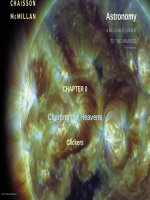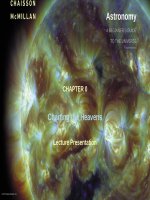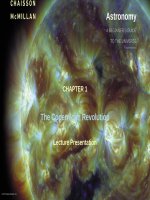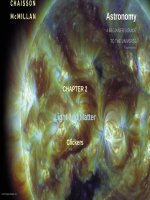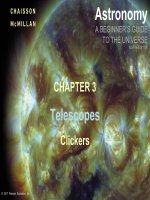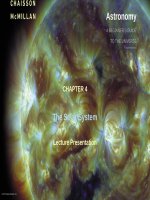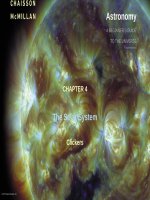Astronomy a beginners guide to the universe 8th CHaisson mcmillan chapter 03
Bạn đang xem bản rút gọn của tài liệu. Xem và tải ngay bản đầy đủ của tài liệu tại đây (4.86 MB, 39 trang )
Astronomy
A BEGINNER’S GUIDE
TO THE UNIVERSE
EIGHTH EDITION
CHAPTER 3
Telescopes
Lecture Presentation
© 2017 Pearson Education, Inc.
Chapter 3 Telescopes
© 2017 Pearson Education, Inc.
Units of Chapter 3
•
•
•
•
•
•
Optical Telescopes
Telescope Size
High-Resolution Astronomy
Radio Astronomy
Space-Based Astronomy
Summary of Chapter 3
© 2017 Pearson Education, Inc.
3.1 Optical Telescopes
•
Images can be formed through reflection
or
refraction.
•
Reflecting mirror
© 2017 Pearson Education, Inc.
3.1 Optical Telescopes
•
Refracting lens
© 2017 Pearson Education, Inc.
3.1 Optical Telescopes
•
Image formation
© 2017 Pearson Education, Inc.
3.1 Optical Telescopes
•
Reflecting and refracting telescopes
© 2017 Pearson Education, Inc.
3.1 Optical Telescopes
•
Modern telescopes are all reflectors:
–
–
–
–
Light traveling through lens is refracted differently depending on wavelength.
Some light traveling through lens is absorbed.
A large lens can be very heavy and can only be supported at the edge.
A lens needs two optically acceptable surfaces, but a mirror needs only one.
© 2017 Pearson Education, Inc.
3.1 Optical Telescopes
•
Types of reflecting telescopes
© 2017 Pearson Education, Inc.
3.1 Optical Telescopes
•
Details of the Keck telescope
© 2017 Pearson Education, Inc.
3.1 Optical Telescopes
•
Image acquisition: Charge-coupled devices (CCDs) are electronic devices that can be
quickly read out and reset.
© 2017 Pearson Education, Inc.
3.1 Optical Telescopes
•
Image processing by computers can sharpen images.
© 2017 Pearson Education, Inc.
Discovery 3.1: The Hubble Space Telescope
•
The Hubble Space Telescope has several instruments.
© 2017 Pearson Education, Inc.
Discovery 3.1: The Hubble Space Telescope
•
Resolution achievable by the Hubble Space Telescope
© 2017 Pearson Education, Inc.
3.2 Telescope Size
•
Light-gathering power: Improves our ability
to see the faintest parts of this galaxy
•
Brightness is proportional to square of radius
of mirror
•
The figure, part (b) was taken with a telescope
twice the size of (a).
© 2017 Pearson Education, Inc.
3.2 Telescope Size
•
Multiple telescopes: Mauna Kea
© 2017 Pearson Education, Inc.
3.2 Telescope Size
•
The VLT (Very Large Telescope), Atacama, Chile
© 2017 Pearson Education, Inc.
3.2 Telescope Size
•
Resolving power: When better, can distinguish objects that are closer together.
© 2017 Pearson Education, Inc.
3.2 Telescope Size
•
Resolution is proportional to wavelength and inversely proportional to telescope size.
© 2017 Pearson Education, Inc.
3.2 Telescope Size
•
Effect of improving resolution:
(a) 10′; (b) 1′; (c) 5″; (d) 1″
© 2017 Pearson Education, Inc.
3.3 High-Resolution Astronomy
•
Atmospheric blurring due to air movements
© 2017 Pearson Education, Inc.
3.3 High-Resolution Astronomy
•
Solutions:
–
–
–
Put telescopes on mountaintops, especially in deserts.
Put telescopes in space.
Use active optics—control mirrors by bending them slightly to correct for atmospheric
distortion.
© 2017 Pearson Education, Inc.
3.4 Radio Astronomy
•
Radio telescopes:
–
–
–
Similar to optical reflecting telescopes
Prime focus
Less sensitive to imperfections (due to longer wavelength); can be made very large
© 2017 Pearson Education, Inc.
3.4 Radio Astronomy
•
Largest radio telescope: 300-m dish at Arecibo
© 2017 Pearson Education, Inc.
3.4 Radio Astronomy
•
•
Longer wavelength means poorer angular resolution.
Advantages of radio astronomy:
–
–
–
Can observe 24 hours a day.
Clouds, rain, and snow don’t interfere.
Observations at an
entirely different
frequency get totally
different information.
© 2017 Pearson Education, Inc.
